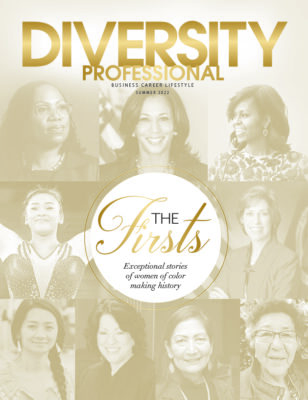INCLUSIVE TRAINING: 6 QUESTIONS EVERY LEADER SHOULD ASK
When you role model inclusiveness, you positively impact individuals, business, and society.
If you think of a leader as someone who marshals people’s talent and potential to meet objectives and fulfill a mission, then obtaining diverse perspectives is a no-brainer. By inviting multiple perspectives, diversity and inclusion reveal the vantage points of a wide range of people. Those diverse perspectives, which will undoubtedly be different from yours, will allow you to view your goals, objectives, and ideas differently, anew. Any goal, concept, or problem to solve can be dramatically improved by thinking about it in a new way. Diversity enhances creative and analytical thinking.
“Obtaining multiple perspectives from a diverse group of people is one of the most important elements needed to succeed in any company. Applying those perspectives to work could drive innovation and massive creativity in ways less diverse teams cannot. Diverse groups of people have different experiences. Utilizing their experiences could expand thinking and research, which would create better products and smarter outcomes for consumers,” advises Laureen Redlund, lead art director and Global Diversity Action Committee member.
Taking multiple perspectives helps you perceive multiple scenarios, multiple gaps, and potentially multiple gains, ultimately resulting in better ideas and solutions that appeal to more people in more meaningful ways. Ask: Am I generating great ideas and solutions?
Diversity, Equity and Inclusion (DEI) also combats groupthink—that is, the conformity that happens when similar people, who might be unfamiliar with outside perspectives, work in a group. A team or a community of similar people tend to think alike and might not bring anything dissenting or challenging to a discussion. If you view goals, problems, and ideas from other perspectives, you will begin to see how age, gender identity or expression, neurodivergence, culture, race, ethnicity, religious affiliations, living with disabilities, socioeconomic status, or community characteristics might affect and ultimately amplify your thinking.
Not only will you get unfamiliar perspectives from a diverse group, but you likely will get different problem-solving input as well. When you augment the way you generate ideas and understand organizational goals and issues, you will find valuable insights into other people that will lead you to more ideas, better ideas, and more significant solutions. Having a diverse and inclusive workforce and teams eliminates groupthink. Ask: How can I avoid groupthink?
To value unique perspectives, voices, and contributions from a diverse and inclusive workforce, cultivate your cultural intelligence, the capacity to function effectively and respectfully with people from different cultures as well as across different cultures. That capacity involves valuing diversity, being cognizant of your own culture, of possible bias, navigating cultural differences, and actively acquiring knowledge of other cultures and contexts.
Every individual comes to the table with a worldview–“a collection of attitudes, values, stories and expectations about the world around us, which inform our every thought and action.” Your worldview is a product of the background and experiences that have shaped you. Your culture, race, ethnicity, gender identity or expression, sexuality, neurocognition, socioeconomic status, friend groups, and other factors all affect your worldview. Once you recognize the factors that shape and impact your worldview, it’s easier to understand that others have different worldviews, experiences, and expectations that are equally valid.
When asked about whether organizational diversity training initiatives work, Robert Livingston, a lecturer at the Harvard Kennedy School who works as both a bias researcher and a diversity consultant, has a proposal: Focus on actions and behaviors rather than hearts and minds. To build your cultural intelligence, learn about your colleagues’ cultures and listen to their viewpoints. Cultural intelligence improves working relationships and collaborative efforts. Ask: Am I building my cultural intelligence?
It’s important to examine your worldview and attitudes about others. To do this, you also have to be cognizant of any implicit bias (prejudice that is present but not consciously recognized), which causes people to think their culture is superior to others, thinking of differences as deficits rather than as informative, valuable perspectives. At times, bias is so veiled it’s difficult to recognize both emotionally and intellectually. For example, although someone might explicitly state that discrimination against individuals based on their age is wrong, that same person could have an implicit bias about people over 50 as it relates to specific careers or capabilities. Ask: Am I acknowledging any implicit bias?
You might think that once you’ve executed DEI initiatives, that is sufficient advocacy. Top-down directives, programs, efforts, and inclusive leadership are critical. However, each of us must take a proactive role for meaningful change to happen. Hiring a diverse and inclusive workforce matters greatly. Developing and adopting the DEI tools necessary for effective change must be linked to the organizational mission, goals, objectives, culture, hiring, and to pay. Ask: How can I connect DEI training to an organizational strategic plan? Am I implementing what I’ve learned?
When you level the playing field, use inclusive language and terms mindfully and respectfully, explicitly state your commitment to DEI and back it up with actions, give an equal shot to everyone, understand how your organization supports DEI, observe diverse celebrations authentically, make people feel included and respected—you are working to get everyone on board to fulfill a meaningful mission and meet organizational objectives. Modeling inclusive leadership is critical to doing so. Ask: How can I get everyone to be equity-oriented?
DEI advances social justice, is a moral imperative, and a shared responsibility. When you role model inclusiveness, you positively impact individuals, business, and society.









